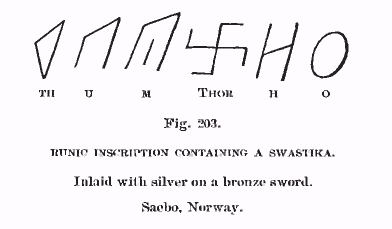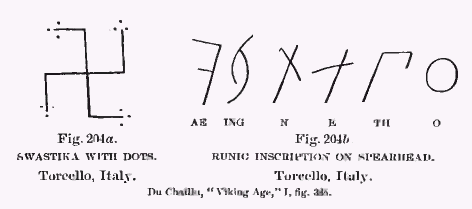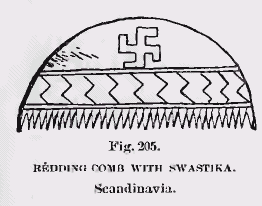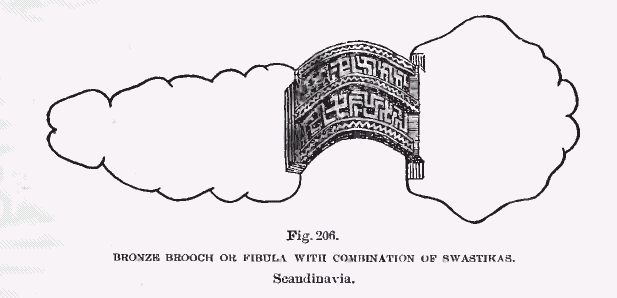|
The Swastika
Dispersion of the Swastika
Page 63
been broken; its use is somewhat
indeterminable, but it is believe by the curator of that museum and others
to have been an arrowhead or spearhead. In form it belongs to Class A
of stemmed implements, is lozenge-shaped, without shoulder or
 barb. It is a little more
than two inches long, five-eighths of an inch wide, is flat and thin.
On one side it bears two oblique of St. Andrew's crosses scratched in
the bone; on the other, a figure resembling the Swastika. It is not the
normal Swastika, but a variation therefrom. It is a cross about three-eighths
of an inch square. The main stem lines cross each other at right angles;
the ends of each of these arms are joined by two incised lines, which
gives it the appearance of two turns to the right, but the junction is
not well made, for the lines of the cross extend in every case slightly
farther than the bent end. The variation from the
barb. It is a little more
than two inches long, five-eighths of an inch wide, is flat and thin.
On one side it bears two oblique of St. Andrew's crosses scratched in
the bone; on the other, a figure resembling the Swastika. It is not the
normal Swastika, but a variation therefrom. It is a cross about three-eighths
of an inch square. The main stem lines cross each other at right angles;
the ends of each of these arms are joined by two incised lines, which
gives it the appearance of two turns to the right, but the junction is
not well made, for the lines of the cross extend in every case slightly
farther than the bent end. The variation from the
 normal Swastika consists of
the variation produced by this second line. This object was lately found
by M. Dupont, of Brussels, in the prehistoric cavern of Sinsin, near Namur.
Most, or many, of these caverns belong to Paleolithic times, and one,
the Grotte de Spy, has furnished the most celebrated specimens of the
skeletons of Paleolithic man. But the cavern of Sinsin was determined,
from the objects found therein, to belong to the Bronze age.
normal Swastika consists of
the variation produced by this second line. This object was lately found
by M. Dupont, of Brussels, in the prehistoric cavern of Sinsin, near Namur.
Most, or many, of these caverns belong to Paleolithic times, and one,
the Grotte de Spy, has furnished the most celebrated specimens of the
skeletons of Paleolithic man. But the cavern of Sinsin was determined,
from the objects found therein, to belong to the Bronze age.
Scandinavia. --- The evidences
of prehistoric culture have great resemblance  throughout
Denmark, Sweden, and Norway; so it is believed that during the prehistoric
ages their peoples had the same culture, and the countries have been classed
together as Scandinavia. throughout
Denmark, Sweden, and Norway; so it is believed that during the prehistoric
ages their peoples had the same culture, and the countries have been classed
together as Scandinavia.
A bronze sword is reported by Mr.
George Stephens (1) as having
been found at Sæbo, Norway, with runes and a Swastika inlaid with
silver. This specimen (fig. 203) was the subject of discussion before
the International Congress of Anthropology and Prehistoric Archæology
(2), at Budapest, 1876. Its
runes were translated by Stephens and being read from right to left. "OH
THURMUTH," or "owns me Thurmuth." But on the same page
he gives another sign for Thu and renders  as Odin or (W)oden. In the discussion before the congress it seems to
have been agreed that the sign
as Odin or (W)oden. In the discussion before the congress it seems to
have been agreed that the sign  stood for "blessing," "good luck," or some beneficent
charm or benediction. A spearhead has been for years displayed in the
museum at Torcello, near Venice, Italy, with a Swastika sign (fig. 204a)
prominent as an engraved sign. (3)
Associated with it, but not a part of it, was an inscription (fig. 204b),
which has always been attributed to the Etruscans. Mr. I. Undset, an archæologist
in the museum of Christiana, made an extended visit through Italy, in
1883, and on seeing this spearhead recognized the inscription as runic
and belonging to Scandinavia. The arms of the Swastika turned to the left,
and the ends were finished with three dots of the same style as those
described employed in the Croix swasticale (fig. 12). Figs. 205
and 206 represent articles of dress or toilet, and bear the Swastika.
The first shows a redding comb, the Swastika on which turns to the right.
It was
stood for "blessing," "good luck," or some beneficent
charm or benediction. A spearhead has been for years displayed in the
museum at Torcello, near Venice, Italy, with a Swastika sign (fig. 204a)
prominent as an engraved sign. (3)
Associated with it, but not a part of it, was an inscription (fig. 204b),
which has always been attributed to the Etruscans. Mr. I. Undset, an archæologist
in the museum of Christiana, made an extended visit through Italy, in
1883, and on seeing this spearhead recognized the inscription as runic
and belonging to Scandinavia. The arms of the Swastika turned to the left,
and the ends were finished with three dots of the same style as those
described employed in the Croix swasticale (fig. 12). Figs. 205
and 206 represent articles of dress or toilet, and bear the Swastika.
The first shows a redding comb, the Swastika on which turns to the right.
It was
 probably of bone or horn,
as are those of modern times. Fig. 206 shows a brooch, the interior decoration
of which is a combination of Swastikas more or less interlaced. It is
of bronze and was used as a dress ornament. Fig.
207 shows a large brooch, the bodies and bar of which are almost covered
with the tetraskelion style of Swastika. There are six of the four armed
Swastika, four of which turn to the left and two to the right. Another
is triskelion, the arms of which turn to the right. In Scandinavia more
than in other countries the Swastika took the form of a rectangular body
with arms projecting from each corner and bending in a spiral form, sometimes
to the right, sometimes to the left.
probably of bone or horn,
as are those of modern times. Fig. 206 shows a brooch, the interior decoration
of which is a combination of Swastikas more or less interlaced. It is
of bronze and was used as a dress ornament. Fig.
207 shows a large brooch, the bodies and bar of which are almost covered
with the tetraskelion style of Swastika. There are six of the four armed
Swastika, four of which turn to the left and two to the right. Another
is triskelion, the arms of which turn to the right. In Scandinavia more
than in other countries the Swastika took the form of a rectangular body
with arms projecting from each corner and bending in a spiral form, sometimes
to the right, sometimes to the left.
ENDNOTES:
1.
"Old Northern Runic Monuments," pt. 3, p. 407. [Back]
2. Proceeding of the Eighth Session, I, pp. 457-460.
Back
3. Du Chaillu, "Viking Age," I, fig. 335.
H. Mis. 90, pt. 2 ---- 55 Back
<< Previous Page
Next
Page >>
© 2004-2007 Northvegr.
Most of the material on this site is in the public domain. However, many people have worked very hard to bring these texts to you so if you do use the work, we would appreciate it if you could give credit to both the Northvegr site and to the individuals who worked to bring you these texts. A small number of texts are copyrighted and cannot be used without the author's permission. Any text that is copyrighted will have a clear notation of such on the main index page for that text. Inquiries
can be sent to info@northvegr.org.
Northvegr™ and the Northvegr symbol are trademarks and service marks
of the Northvegr Foundation.
|
> Northvegr™ Foundation
>> About Northvegr Foundation
>> What's New
>> Contact Info
>> Link to Us
>> E-mail Updates
>> Links
>> Mailing Lists
>> Statement of Purpose
>> Socio-Political Stance
>> Donate
> The Vík - Online Store
>> More Norse Merchandise
> Advertise With Us
> Heithni
>> Books & Articles
>> Trúlög
>> Sögumál
>>
Heithinn Date Calculator
>> Recommended Reading
>>
The 30 Northern Virtues
> Recommended Heithinn Faith Organizations
>> Alfaleith.org
> NESP
>> Transcribe Texts
>> Translate Texts
>> HTML Coding
>> PDF Construction
> N. European Studies
>> Texts
>> Texts in PDF Format
>> NESP Reviews
>> Germanic Sources
>> Roman Scandinavia
>> Maps
> Language Resources
>> Zoëga Old Icelandic Dict.
>> Cleasby-Vigfusson Dictionary
>> Sweet's Old Icelandic Primer
>> Old Icelandic Grammar
>> Holy Language Lexicon
>> Old English Lexicon
>> Gothic Grammar Project
>> Old English Project
>> Language Resources
> Northern Family
>> Northern Fairy Tales
>> Norse-ery Rhymes
>>
Children's Books/Links
>> Tafl
>> Northern Recipes
>> Kubb
> Other Sections
>> The Holy Fylfot
>> Tradition Roots

Please Visit Our Sponsors
- Référencement
- Alfaleith.org - Heithni, Viðartrú
- Odin's Journey
- Baman - Iceland/Aboriginal Australia
- Biker's Booty
- Création site Internet Paris
- Pagan T-shirts
- Appartements
- Chalets au Québec
- Logo Designers
- Web Design
- Appartements Montreal
- Espace Bureau Montreal
- London Tours
- Spanish Property Legal Advice
- Multi Pret Hypotheque
- Company Logo Design
- Wiccan T-shirts
- Art Gallery, Painting artists
- free logo design reviews
- Heathen, Heathenism, Norse Pagan
- Logo design by LogoBee
- Pagan Shirts
- Norse Pagan Religion
- Triumph, BSA, Norton, Euro Motorcycles - Accessories
- Logo Maker
- Logo Design - Business Logos, Inc.
- Logo Design - Logo Maker
- Create A Website
- Wiccan Shirts
- Mortgages
- Multi-Prêts Hypothèques
- Viking T-shirts
- Hewlett Packard Ink Cartridges
- Indian Recipes
- Logo Design London
- Logo Design
- Logo Design UK
- Subvention et financement PME
- Heathen T-shirts
- Medical Alert, Emergency response
- orlando hotels
- Slot Machines for Vikings
- Norse Pagan Clothing and Merchandise
- New Homes
- Branding Irons
- Bachelor Degree Online
- Online Degree
- College Degree
- Heathen, Viking and Norse Texts
- Création site Internet
- Montreal Web Design
- Free Dish Network Satellite TV
- Discount ink cartridge & laser cartridge
- DUI Lawyers & DWI Attorneys
- Promotional Products
- Ready-Made Company Logos
- Canadian Art Dealer
- Best CD Rates
- Laser Toner Cartridge
- Logotyper & Grafiska Profilprogram
- Banner Design
- Custom Logo Design
Web site design and coding by Golden Boar Creations
|
|




 throughout
Denmark, Sweden, and Norway; so it is believed that during the prehistoric
ages their peoples had the same culture, and the countries have been classed
together as Scandinavia.
throughout
Denmark, Sweden, and Norway; so it is believed that during the prehistoric
ages their peoples had the same culture, and the countries have been classed
together as Scandinavia. 
